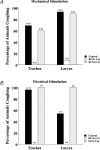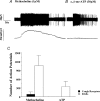Identification of the tracheal and laryngeal afferent neurones mediating cough in anaesthetized guinea-pigs
- PMID: 15004208
- PMCID: PMC1665106
- DOI: 10.1113/jphysiol.2003.057885
Identification of the tracheal and laryngeal afferent neurones mediating cough in anaesthetized guinea-pigs
Abstract
We have identified the tracheal and laryngeal afferent nerves regulating cough in anaesthetized guinea-pigs. Cough was evoked by electrical or mechanical stimulation of the tracheal or laryngeal mucosa, or by citric acid applied topically to the trachea or larynx. By contrast, neither capsaicin nor bradykinin challenges to the trachea or larynx evoked cough. Bradykinin and histamine administered intravenously also failed to evoke cough. Electrophysiological studies revealed that the majority of capsaicin-sensitive afferent neurones (both Adelta- and C-fibres) innervating the rostral trachea and larynx have their cell bodies in the jugular ganglia and project to the airways via the superior laryngeal nerves. Capsaicin-insensitive afferent neurones with cell bodies in the nodose ganglia projected to the rostral trachea and larynx via the recurrent laryngeal nerves. Severing the recurrent nerves abolished coughing evoked from the trachea and larynx whereas severing the superior laryngeal nerves was without effect on coughing. The data indicate that the tracheal and laryngeal afferent neurones regulating cough are polymodal Adelta-fibres that arise from the nodose ganglia. These afferent neurones are activated by punctate mechanical stimulation and acid but are unresponsive to capsaicin, bradykinin, smooth muscle contraction, longitudinal or transverse stretching of the airways, or distension. Comparing these physiological properties with those of intrapulmonary mechanoreceptors indicates that the afferent neurones mediating cough are quite distinct from the well-defined rapidly and slowly adapting stretch receptors innervating the airways and lungs. We propose that these airway afferent neurones represent a distinct subtype and that their primary function is regulation of the cough reflex.
Figures








References
-
- Advenier C, Lagente V, Boichot E. The role of tachykinin receptor antagonists in the prevention of bronchial hyperresponsiveness, airway inflammation and cough. Eur Respir J. 1997;10:1892–1906. - PubMed
-
- Bergren DR. Sensory receptor activation by mediators of defense reflexes in guinea-pig lungs. Respir Physiol. 1997;108:195–204. - PubMed
-
- Bergren DR, Sampson SR. Characterization of intrapulmonary, rapidly adapting receptors of guinea pigs. Respir Physiol. 1982;47:83–95. - PubMed
-
- Bolser DC, Aziz SM, Chapman RW. Ruthenium red decreases capsaicin and citric acid-induced cough in guinea pigs. Neurosci Lett. 1991;126:131–133. - PubMed
Publication types
MeSH terms
Substances
Grants and funding
LinkOut - more resources
Full Text Sources
Medical

